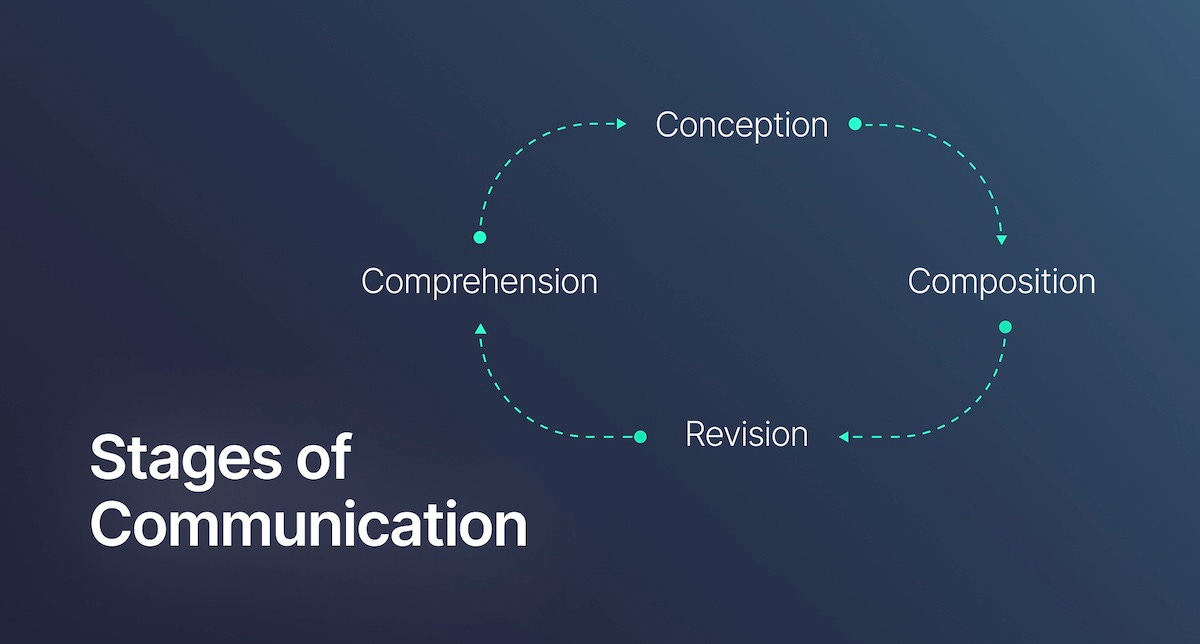Grammarly to Add Generative AI Writing Features in April
This sets a collision course with Jasper AI, Wordtune ... and Microsoft
Grammarly announced today that it will add generative AI features in April. This marks a significant change for the company. Rahul Roy-Chowdhury, the global head of product at Grammarly, said in a blog post:
To date, we’ve been focused on the revision stage of the communication lifecycle. By embracing new technologies like generative AI, we can advance our vision of supporting the entire process—from conception to comprehension. Grammarly is committed to using the most effective technologies available to solve real individual and organizational problems in everyday communications—from overcoming writer’s block to tackling an email backlog in minutes, and more.
Expanding the Stages of Communication
This move is not surprising. The diagram above shows that Grammarly today resides in the third stage of the communication process, Revision. That means it faces potential disruption by tools that occupy the earlier stages, such as Conception and Composition. New AI writing assistants such as Jasper AI have leveraged GPT-3 to tackle those steps and have the potential to render Grammarly’s revision tools unnecessary.
With that in mind, Grammarly will introduce new features, including idea and outline development (Conception) and initial draft writing (Composition). The new product features in GrammarlyGO sound a lot like Jasper AI’s pitch.
With GrammarlyGO, individuals and businesses can use generative AI to:
Rewrite for tone, clarity, and length: Transform writing to be clear and on target, whatever the context.
Compose: Type a prompt and watch GrammarlyGO compose high-quality writing, saving time finding the perfect words.
Ideate: Unblock writing with GrammarlyGO as an AI ideation partner and unlock creativity with GrammarlyGO’s outlines and brainstorms, generated from prompts.
Reply intelligently: Flow through emails quickly with GrammarlyGO, which understands an email’s context and instantly drafts a thoughtful reply.
Jasper AI often stresses the benefit of tackling the blank page, which is clearly a value proposition that Grammarly wants to promote as well. However, Jasper is also increasingly focused on marketing department use cases. “Create amazing [insert your marketing task here] 10x faster with AI.” Grammarly seems to be sticking with a more generalized solution instead of optimizing for marketing tasks.
Competing for Users
Like Canva and Picsart, Grammarly is about to introduce a large user base to generative AI integrated into a tool they already employ. Adopting Jasper or ChatGPT requires a new monthly fee, learning new tools, and changing your current writing process. Grammarly users will simply be able to add these features next month to their current writing process. While it is impressive that Jasper AI has over 100,000 paying users, Grammarly has said in the past that it has over 30 million daily active users. The scale is not comparable.
This doesn’t mean that Grammarly’s move will eliminate competition from AI writing assistants. Thirty million users is actually a small fraction of people that will eventually benefit from writing assistant features. It also doesn’t mean that Grammarly will have the right set of features and user experience to capture the most market share. Wordtune’s summarization and Spices features and Jasper’s templates offer clear value to many users. The key from a competitive standpoint is that Grammarly will have a head start because it can simply push the new features directly to its existing customers.
I also suspect that this announcement will create pressure on Wordtune to add generative writing features. Like Grammarly, Wordtune today focuses on the revision process that involves enhancing existing compositions. It may turn out that the revision features are more widely adopted than creating the initial draft. However, many users are likely to want the option of ideation (conception) and composition features at least some of the time. Today, they would have to use another tool.
With that said, this is a matter of philosophy and not technology for Wordtune. AI21, the creator of Wordtune, already has very capable text generation capabilities in its own large language models (LLM). It is just a matter of turning those features on to round out its feature set. This could be a significant advantage for Wordtune over time as all of its key rivals depend on other companies to provide their LLM features which ultimately will limit how much customization they can offer.
New Expectations Around Writing
We may be in the midst of the large language model wars, but that is spawning battles and outright wars in several other segments. Search took center stage last month as Microsoft and Google sought to position themselves for a new era. Browsers are an emerging battleground as well as AI models could shape how we consume web content.
AI writing assistants are one of the five product categories that LLMs have already disrupted, and the competition is heating up. Grammarly’s move is notable as it shows an incumbent in the writing assistance space taking on the newcomers directly with a similar set of generative AI features. The next big moves will come from Microsoft Word and Google Docs. Those two services dwarf Grammarly and will cause a new shakeup in the battle for AI writing assistant market share. Is someone about to get squeezed?
We are just getting started.





